|
- Catalog (on stock)
- Back-Catalog
- Mail Order
- Sounds
- Workshops
- Instruments
- Projects
- History Face
- ten years 87-97
- Review Face
- our friends
- Albis Face
- Albis - Photos
- Links
- Home
- Contact
- Profil YouTube
- Profil facebook
P & C December 1998
- Face Music / Albi
- last update 07-2009
|
1. Sahari – 1:06
2. Hinan ekav, shaghetsek (The henna is here, knead/mix it) – Armtan, in the province of Erzurum – 0:38
3. Mek dzerkd hinaye (Color one hand with henna) – Akn, in the region of Kharberd – 0:50
4. Harsanekan yerg hinayi (Wedding song of coloring with henna) – Akn, in the region of Kharberd – 0:48
5. Mek dzerkd hinaye (Color one hand with henna) – 1:02
6. Mi la, mayrik (Don’t cry, mother) – Kars, in the region of Shirak – 1:17
7. Mayrik, du mi la (Don’t you cry) – region of Moush – 0:48
8. Tagavor, inch berem kyo nman (King, what can I bring, compared to you?) – 2:27
9. Oy, yaman gharipo (Oy, yaman, emigrant) – Khasdur, in the region of Moush – 3:43
10. Papik, doo halal (Grandfather, bless me) – Chmshkatsag, in the region of Kharberd – 1:59
11. Chem yertar, merik (I won’t go, mother) – Khlat, in the region of Bitlis – 5:08
12. Tagvor, inch berem kyo nman (King, what can I bring, compared to you?) – region of Van – 6:31
13. Meshkd ilik goti (Your waist is delicate like a spindle) – 1:54
14. Harsin taneloo yerg (Carrying off the bride) – Musa Ler (now in Syria) – 2:24
15. Ha janum, elek jrag varetsek (Dear one, go and light the lantern) – region of Gurin – 1:59
16. Mer tagvorner elan saren (Our kings came from the mountain) – region of Talin – 4:24
17. Kez tanel enk eker (We came to take you) – Chmshkatsag, in the region of Kharberd – 3:11
18. Kertam, mayrik (I’ll go, mother) – 1:29
19. Yerknoots getnoots (From the sky to the earth) – 1:16
20. Orhneal, Barerar Astvats (Bless us, beneficent God) – 1:00
21. Etchmiadzna zorootenov (With the strength of Etchmiadzin) – 0:52
22. Tanel ekank (We came to take you) – Gurin, in the region of Sebastia – 2:20
23. Taran, Taran (They took her away) – 2:29
24. Tagvoragovk (Praise of the Groom) – region of Talin – 3:45
25. Gnatsek asek (Go and tell) – 2:37
26. Tamzara – region of Tamzara – 1:29
27. Barov dzer moorazin hasnek (Reach your goals with goodness) – region of Taron – 2:23
28. Tagvori mer (King’s mother) – Shatakh region of Moks – 1:48
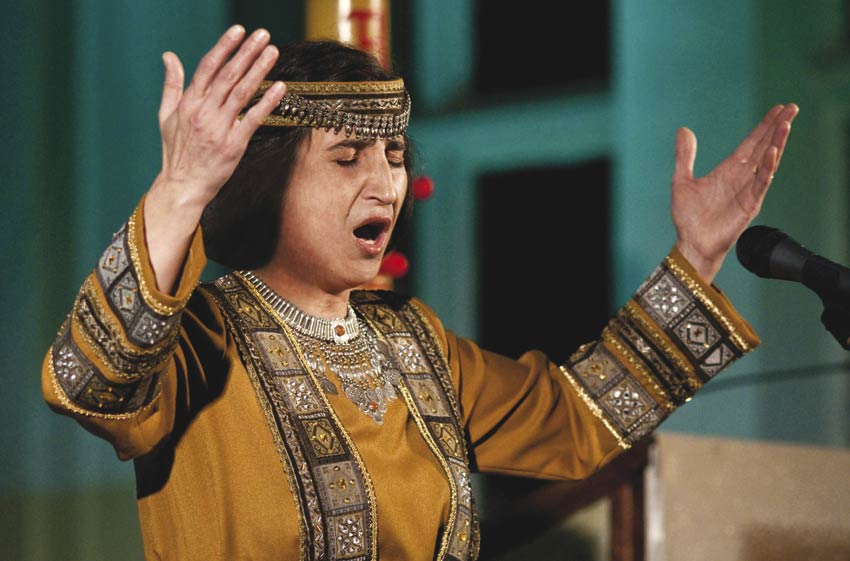
Hasmik Harutyunyan
|
|
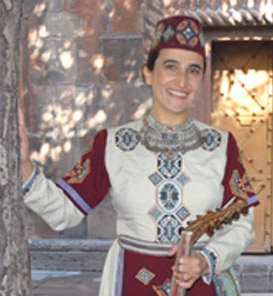 |
- Hasmik Harutyunyan
Hasmik was born in Yerevan in 1960. Her ancestors are from Moush. She graduated from the Department of Vocal Music at the Arno Babajanyan School of Music and the Yerevan State Pedagogical Institute. For several years, she worked as soloist for the “Agoonk” Ensemble of Armenian National Radio. Hasmik is a member of the Karot Ensemble and is vocalist for the Shoghaken Folk Ensemble. She is the artistic director of the Hayrik Mouradian Children's Folklore Song and Dance Ensemble.
|
|
 |
- Aleksan Harutyunyan
Aleksan was born in 1962 in Yerevan, Armenia. His ancestors are from the province of Moush in Historical Armenia. He graduated from Yerevan State University and the Komitas State Conservatory. For several years, he worked for the "Agoonk" Ensemble of the Armenian National Radio as a soloist, and later as the group's director. He is a member of the Karot Ensemble and a soloist for "Kohar" and the Shoghaken Ensemble.
|
|
|
| Wedding circle dance in Van (pre-1915) |
Traditional Wedding Songs
Every nation, during the course of its long history, has formed its own distinct traditions, lifestyle, and ceremonies. As others, the Armenian nation has created and preserved its traditions and beliefs, thanks to thepreservation and performance of these many ceremonies and rituals.
The word ceremony can be defined as order, or sequence. This took place in the early stages of the development of mankind. According to the times, along with their history and economy, the manner in which these ceremonies performed were changed, and certain ceremonies, deprived of their foundation, faded from history, while many took on new meaning. Still others became subject to political or religious rules. In this way, many ceremonies, along with the songs that accompanied them, were forgotten, but many, often from the most ancient times, have reached us. Those that lasted were of a social nature and had a strong foundation and were eternal, or permanent (such as weddings and funerals).
Wedding songs are considered to be all those songs connected with the actual ceremony, and are performed during the time of the wedding. This ceremony is often presented as a theatrical ceremony or rite, where various games, fables, jokes, laments and praise, prayers, and dances and dance songs, much like a historyfable, become the plot of an entire play.
Due to the patriarchal nature of the Armenian family, marriage, or the wedding ceremony, becomes one of the most important events in Armenian society, especially in the village, where traditions have always assumed a great importance.
The wedding is one of the oldest and most beloved of all ceremonies, and until today it has not lost its topical nature or importance. No other ceremony presents the manners, customs, habits and traditions of a people than the wedding.
The wedding ceremony is a festivity in which the rules are strictly followed; in old times the ceremony lasted seven days, each day playing a special part and having special meaning, such as the baking of lavash (flat bread) or gata (sweet bread), the butchering of a young bull, the evening in which the bride is ceremonially dressed, the shaving of the groom, and the decorating of the “Tree of Life” and praising of the groom.
Each of these special ceremonies is accompanied by traditional songs and dances, with specific instrumental melodies, which adds meaning to each period, or segment, of the wedding ceremony. The most beautiful of these traditional songs are those praising the bride and groom; also strictly traditional is the “call” of the zurna announcing the beginning of the butchering ceremony, the “call” (known as ‘Sahari’) being in the form of a mugham (eastern improvisational style), as well as the bridal laments, in which songs are sung by the bride about the sadness in leaving her family home, dance songs dedicated to the groom’s mother, praise of the godfather and in-laws, as well as certain humorous songs ridiculing or mocking members of the wedding party.
Symbolism associated with the wedding ceremony, connected with the ceremonial rite, is deepest and most meaningful in the ceremony of preparation of the king’s “Tree of Life” (in this case the king meaning the groom) and the songs associated with this ceremony. Existing proofs witness to the fact that the portrayal of the “Tree of Life” has a reciprocal tie to marital relations and the system of genealogical structure. The preparation and praise of the groom’s “Tree of Life” for the wedding ceremony is nothing other than the “Tree of Life”, the symbol of eternity, for the new couple and newly-formed family, their relatives, and all of their ancestors. The tree also has other names, such as “Khnki Tsar” (Tree of Incense) and “Urtsi Tsar” (Tree of Thyme), as both incense and thyme are known for their cleansing properties. The first part of the ceremony of the decoration of the tree is accompanied by song.
Wedding songs are performed in groups, as solos, and as duets, as well as one following the other during the wedding ceremony. Each and every ceremonial song has its structural and progressive beginning. The songs that the bride’s girlfriends sang the night before the wedding, until daybreak, are called “Tsaghkots” (Flower Garden). In these songs, the girls praise their girlfriend-bride, comparing her to a tree, a flower, and the moon. During the actual wedding ceremony they also praise the bride and groom’s beauty, youth, and other worthy qualities. By nature the songs of praise are bright and with pomp. In these songs, the groom is named king, comparing him to the sun and presenting him with the bride, decorated and ornamented, even at times dressing him in actual king’s attire. They compare the bride to the moon and present her as talented and graceful, and efficacious homemaker.
Wedding prayers, supplications, and blessings (Orhneal barerar Astvats) are also manifested in wedding songs.
Dances and song dances play a great part in the wedding ceremony. In their performance, there is a limited, ordered sequence. In this way, in certain provinces, with the help of musicians, the entire village population was invited to the wedding.
Wedding songs also include songs of humor, as Komitas said, “pleasant, or facetious” songs that are connected with the godfathers of the wedding. These “joke” songs, though, were in no way intended to hurt anyone’s feelings, but were just that, songs of humor.
Also classified in this list of wedding songs are the “songs of weeping.” Those weeping are the bride, her mother, and her sister. The reasons for weeping were many: one might be the hard, unattractive life awaiting the future bride in old world, patriarchal families; another would be the bride who wasn’t given a choice as to whom she would marry, thus her sad, unsteady psychological state. But the main reason for the bride weeping was the fact that she was leaving her father’s home, leaving her family. At one and the same time, the songs of weeping were directed as saying thank you, expressing gratefulness to her parents.
The wedding ceremony and, especially the songs, with their uniqueness and variety, manifest a people’s social and familial life, as well as their way of life and customs, and present rich material to study about the manners, morals, and traditions of a traditional family. At the same time, an interesting social picture (scene) is created, as Komitas expressed, a grand, artistic, and poetic presentation.
- Special information about wedding music in Akn, region of Kharberd:
In Akn, the people used instruments to accompany the song, but not zurna and dhol, but kamancha, kamani (string instrument similar the rababah), dap, and saz to accompany the wedding ceremony, and had high quality musicians.
The music had a unique and special hue, different from any other region. Songs sung by girls and women were accompanied by the dap, without other musicians.
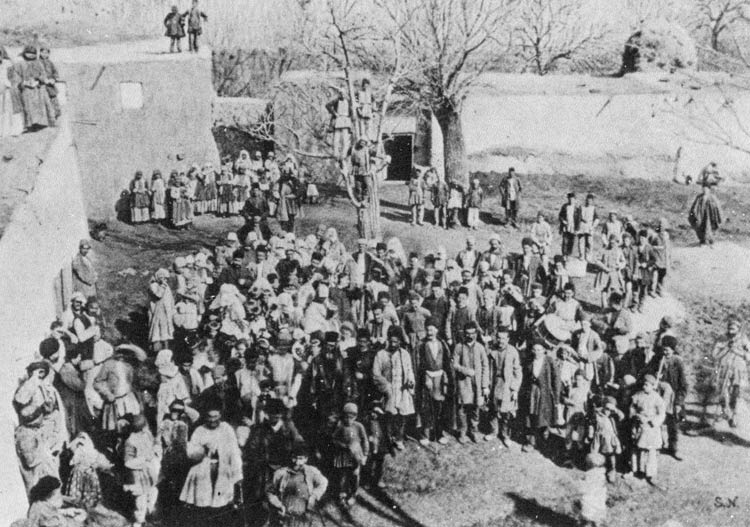 |
| Armenian villagers gathering for a wedding |
The Songs
| 1. Sahari |
| - Norayr Kartashyan: zurna solo |
| Literally means “sunrise.” A call, usually with a zurna, although occasionally by a kamancha, duduk, or blul, to announce the beginning, or a certain phase, of the wedding. It is improvisational, or mugham, in nature. |
| Over the course of centuries, during national holidays and ceremonies, the performance of songs and melodies has been something both necessary and symbolic, and which in their depths preserve their earlier meaning and the beginnings of the musical constructions of the songs and melodies. Independent of which genre, social level, or belief they belong to, they are considered as symbolic melodies. These are, for example, Tagvoragovk “Praising the king (groom),” Sahari “Sahari,” Aravot Luso “Morning Light,” Harsi Voghbu “Lament of the Bride,” Avetisneru “Songs of Good Tiding,” Nuri-Nurineru (ceremony to bring rain), Jan Gyulumneru (songs of Resurrection), as well as songs, and their instrumental versions, that have become part of the funeral ceremony, such as Dle Yaman, Vorskan Akhper (Brother Hunter), and Sev Moot Amper (Black Dark Clouds). |
| The name “Sahari,” which has been passed to the Armenians from the Persians and Arabs, means “sunrise” or “dawn.” This term was first seen in the 16th century in the works of poet Grigor Akhtamartsi. The name “Sahari” has thusly been given to one of the melodies that Armenians have used over the centuries. The playing of the “Sahari,” being so widespread, has become a tradition among Armenians everywhere, and even possesses its own special genre. It is traditionally played in a special free improvisational, or mugham, style, usually played by a zurna, but at times with a kamancha, duduk, or even srink. In the people’s language, “Sahari” simply means “mugham,” played by an instrument. And even though the “Sahari” isn’t classed in the list of the strict mughams, with its improvisational nature and other unique characteristics it has found its place as a special branch of Armenian monadic music. |
Lilit Yernjakyan (Professor of musicology and Eastern studies)
|
|
| 2. Hinan ekav, shaghetsek (The henna is here, knead/mix it) |
- Hasmik Harutyunyan: voc solo
|
The henna is here, knead it,
The henna is here, knead it.
|
Transcribed by Mihran Toumajan. Toumajan learned the song from Ovsanna Ormanian, in 1923. Ormanian was born in the village of Armtan, in the province of Erzurum. It is a very important part of the wedding ceremony process, when the henna is brought into the prewedding process. The “hina” song lyrics tell of decorating, or coloring, one hand, while leaving the other uncolored, to be able to do work for the new family.
|
|
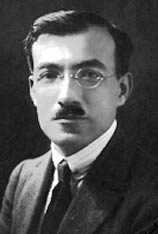 |
Mihran Toumajan (See also song no. 3,10,11,12,15,17 and 22):
Noted ethnomusicologist, conductor, author, and preserver of Armenian music and folklore, the late Mihran Toumajan, was born in Gurin, Western Armenia in 1890. As one of the five devoted pupils of the great Komitas Vartabed, and a member of Constantinople’s famous Kousan Chorus, Toumajan is regarded as an authority on the origin of Armenian folk music. In the aftermath of the Armenian Genocide, Toumajan immigrated to the United States where he resided and worked for over forty years. In addition to conducting the Armenian National Chorus in Boston and New York, he sought and interviewed genocide survivors, and, most importantly, notated, recorded and preserved their native folk songs. In 1964, Toumajan accepted an invitation from the Soviet Armenian government to move to Yerevan and publish his research. Following in the footsteps of Komitas, Toumajan’s four-volume publication, entitled “The Song and Word of the Fatherland” (“Hayreni Yerk u Ban”), contains a rich collection of songs rooted in various regions of historic and present-day Armenia. While Toumajan entered his eternal rest in Yerevan on October 28, 1973, his prolific life and works remain ingrained in the hearts and minds of his friends, students and devotees, and in the repertoire of current generations of Armenian folk ensembles and musicians.
|
|
|
| 3. Mek dzerkd hinaye (Color one hand with henna) |
- Hasmik Harutyunyan: voc solo
|
Color one hand with henna;
Don’t color the other,
To take the cares of your mother.
|
This is version one of the song. Transcribed by Mihran Toumajan. Toumajan learned the song from Vardanush Yeghikyan, who was born in the village of Binkyan, near Akn, in the region of Kharberd. Transcribed in New York City, in 1936, when Yeghikyan was 49 years of age.
|
|
| 4. Harsanekan yerg hinayi (Wedding song of coloring with henna) |
- Hasmik Harutyunyan: voc solo
|
This henna is not ordinary henna,
The boy (groom) who sends it is very handsome.
|
From the book by H. Janikyan. The song originates in Akn, region of Kharberd. It is from the same place as the other “hina” songs. Janikyan transcribed the song. Komitas has another version of the song, which differs from Janikyan’s version.
|
|
| 5. Mek dzerkd hinaye (Color one hand with henna) |
- Hasmik Harutyunyan: voc solo
|
Color one hand with henna;
Don’t color the other,
To take the cares of your father-in-law.
|
This is version two. Transcribed by Mihran Toumajan. Toumajan learned the song from Ovsanna Ormanian, in 1923.
|
|
| 6. Mi la, mayrik (Don’t cry, mother) |
- Hasmik Harutyunyan: voc solo
|
Don’t cry, mother, don’t cry.
Ah, I am the one who is crying.
I am the emigrant (going to another home).
|
Transcribed by musicologist Hakob Harutyunyan. He was a student of Komitas at the seminary in Etchmiadzin, at the time when Komitas assigned his students the task of collecting folk songs when on vacation from the seminary. Harutyunyan transcribed his version in the province of Kars, in the region of Shirak, while Komitas transcribed a different version in Alashkert.
|
|
| 7. Mayrik, du mi la (Don’t you cry) |
- Hasmik Harutyunyan: voc solo
|
Mother, don’t cry,
I am the one who must cry.
I am the one leaving.
|
A song in which the bride is bidding farewell to the family home. The song is from Moush.
|
|
| 8. Tagavor, inch berem kyo nman (King, what can I bring, compared to you?) |
- Aleksan Harutyunyan: voc solo
|
King, what can I bring, compared to you?
Similar to your green and red sun.
Eternal flower, which will bloom
As your sun.
|
The song is sung by girls, as they give flowers to the groom (the king) so that he weaves a wreath and gives it to his bride (the queen). As they sing, they say the name of the flower they are giving to the groom. The song is from the Hayrik Mouradian song book.
|
|
| 9. Oy, yaman gharipo (Oy, yaman, emigrant) |
- Hasmik Harutyunyan: voc solo
|
Oy, yaman emigrant.
Trees, don’t move,
I am the one who must move.
I am the emigrant.
Trees, don’t move.
|
A song in which the bride is leaving the family home, during the time when the bride’s hair is being braided. Komitas transcribed it in Alashkert, in the region of Moush, in the village of Khasdur. Komitas wanted to use this melody in his version of Anush Opera, which was never completed.
|
|
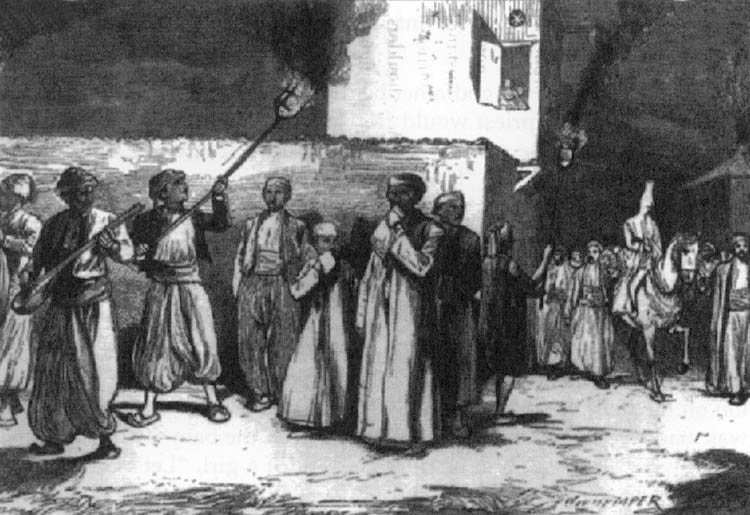
|
An Armenian wedding procession sketched in the nineteenth century
|
|
|
| 10. Papik, doo halal (Grandfather, bless me) |
- Hasmik Harutyunyan: voc solo
|
Grandfather, bless me.
Grandfather, bless me.
I have eaten your bread (you have raised me).
Don’t worry, you are worthy.
|
This song is from the village from Chmshkatsag, near Akn, a town in the region of Kharberd. Mihran Toumajan transcribed this in the USA from the Jellalian family. In the song, the bride is asking her grandfather to bless her. This song presents the part of the wedding ceremony in which the bride is leaving her family home. This and similar songs trace back to pagan times.
The village of Chmshkatsag was similar in lifestyle and culture, including the style and nature of its songs, to towns like Akn, Erznka, Kghi and Palu.
|
|
| 11. Chem yertar, merik (I won’t go, mother) |
- Hasmik Harutyunyan: voc solo
|
I won’t go, mother, I won’t go;
They’ll take me by force.
Sit me on a red-colored horse
and take me off at my lover’s house.
I won’t go, mother, I won’t go;
They’ll take me by force.
|
Mihran Toumajan transcribed the song, hearing it from Anush Grigoryan. It is from Khlat (Bitlis region). M. Toumajan, when writing about this song, tells that Komitas called wedding songs “songs of blooming, or planting.” In this song, the bride is bidding farewell to her family home… “I will cry, but I will go…” Even though the bride says she won’t go, in reality, she knows she is leaving her family home.
|
| 12. Tagvor, inch berem kyo nman (King, what can I bring, compared to you?) |
- Aleksan Harutyunyan: voc solo, kopalov dhol and Norayr Kartashyan: pku
|
King, what can I bring, compared to you?
Like your green sun.
When the apricot tree blooms,
(To the bride and groom) Bloom like the apricot tree.
|
Mihran Toumajan transcribed this song, hearing it from Tigran Chituni, in Paris, in 1920-22. It
is from the region of Van. This song praises the groom.
|
|

Armenian Wedding in Adana 1910
|
|
| 13. Meshkd ilik goti (Your waist is delicate like a spindle) |
- Hasmik Harutyunyan: voc solo
|
Your waist is delicate (like an “ilik,” a spindle)
Like an ear with earrings,
I will see you in a bride’s veil.
Break my spoon (so I don’t go back home)
Throw it into the yard.
Cry where the bride has walked.
|
From the collection (first volume) by Mihran Toumajan. A song praising the bride’s delicate beauty, as well as telling of the bride leaving the family home.
|
|
| 14. Harsin taneloo yerg (Carrying off the bride) |
- Hasmik Harutyunyan: voc solo
|
Don’t cry, mother, don’t cry.
They are taking me.
They are taking a girl
Who grew up in sugar and honey.
The girl is dressed and ready,
My lover’s red-colored horse
Is tied to the pomegranate tree.
|
From Musa Ler (on the Mediterranean Sea, now in Syria). The song was learned from Hovhannes Hanesyan in Etchmiadzin, who had fled from Musa Ler. Transcribed by ethnographer and folklorist Verjine Svazlian.
|
|
| 15. Ha janum, elek jrag varetsek (Dear one, go and light the lantern) |
- Hasmik Harutyunyan: voc solo
|
Ah, dear one,
Let’s go and light the lantern.
I’m getting my brother married,
Ah, dear one,
My brother is getting married.
The bride is crying,
Let’s go and light the lantern.
Ah, dear one.
Wrap up the meat in squash,
The bride is crying,
Ah, dear one.
|
From the region of Gurin. Transcribed by Mihran Toumajan. Recorded from three different people, one of whom was Mihran Toumajan’s mother. Recorded by the same people who sang “Tanel Ekank.” Lighting the lantern in this case could be symbolic, as no work or part of the wedding ceremony was done in the dark. Three versions are presented here.
|
|
| 16. Mer tagvorner elan saren (Our kings came from the mountain) |
- Aleksan Harutyunyan: voc solo
|
Our king came from the mountain
Your king came from the mountain
Forty springs flowing from stones
Bless the king and queen.
|
The song was transcribed in Nerkin Bazamaberd village (region of Talin), from Haykanush Grigoryan (born in 1915) from the province of Khut, village of Knot, in Sassoun (Western Armenia). It is a song praising the groom (king).
|
|
| 17. Kez tanel enk eker (We came to take you) |
- Hasmik Harutyunyan: voc solo
|
We came to take you.
We came to take you.
Your mother is crying.
We have brought you a pair of shoes,
Put them on.
Hold your leg straight;
Wear the shoes correctly,
And make us happy.
|
From the same region as “Papik doo halal” (Village from Chmshkatsag, near Akn, in the region of Kharberd). Transcribed by Mihran Toumajan from the same Jellalian family, in the US city of Boston in 1935. This song is about taking the bride from the family home. In asking the bride to wear the shoes correctly, they are asking her to live correctly, and have a happy life.
|
|
| 18. Kertam, mayrik (I’ll go, mother) |
- Hasmik Harutyunyan: voc solo
|
I will go, mother, I will go.
I am leaving; your place will grow larger.
Neighbors and relatives will all cry.
|
This song, as well as other songs with the bride bidding farewell to the family home, is an obviously emotional song. With the Armenians, these feelings are usually kept inside. Komitas placed special importance on this particular song.
This song is sung often, in different versions and lyrics. When Komitas was working on his version of Anush Opera, he tried to use the song, but later decided against doing this.
|
|
|
|
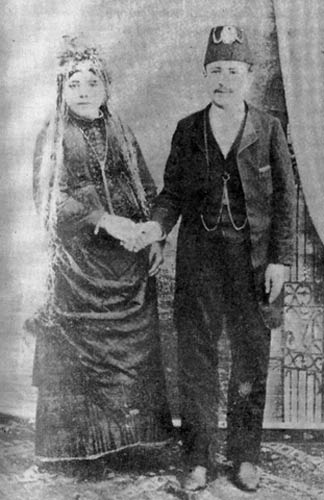 |
| Armenian wedding in Sepastia |
Bride and groom from Talas (1900) |
|
|
| 19. Yerknoots getnoots (From the sky to the earth) |
- Aleksan Harutyunyan: voc solo
|
From the sky to the earth,
With holy strength,
This tree was a flower,
The tree bloomed,
The tree stood straight,
Green and red.
|
Sung by entire group (wedding party) as the “Tree of Life“ is decorated, showing their feelings. When the tree is ready (decorated), it is placed on a table, on a large platter. The text of the song pictures the importance of the “Tree of Life“, which is a symbol of the marriage tie and the establishing of a family.
|
|
| 20. Orhneal, Barerar Astvats (Bless us, beneficent God) |
- Aleksan Harutyunyan: voc solo
|
Bless us, beneficent God
With your will, bless our ceremony
We became a pair, and became whole.
Wearing a crown, we multiplied.
|
After dressing and praising the groom, and after praising the strength and power of Etchmiadzin, the preparation of the “Tree of Life” takes place. This is a ceremony done with song and dance.
During the blessing of the tree, these three songs are sung (songs 19, 20, 21).
|
|
| 21. Etchmiadzna zorootenov (With the strength of Etchmiadzin) |
- Aleksan Harutyunyan: voc solo
|
With the strength of Etchmiadzin, the power of Etchmiadzin,
The tree was a flower;
The tree bloomed, and became whole.
Green and red.
|
Performed similar to a recitation, in an official manner, and is performed by one of the main persons of the wedding, such as the godfather. It is performed more in regular speech as opposed to singing.
|
|
| 22. Tanel ekank (We came to take you) |
- Hasmik Harutyunyan: voc solo
|
We came to take you,
We came to take you.
We came to take you from your mother and father.
If you like, stay a little longer,
If you like, stay a little longer.
It’s enough…get up, let’s go.
|
The song is sung as the bride is taken from the family home. Four versions are presented here. These four were all transcribed by Mihran Toumajan, who heard one version from Almast Hekimian and another from his own mother. The song is from Gurin (a large village in the Sebastia region). The dialect is similar to that of Nakhichevan, an historic Armenian region now located in Azerbaijan.
|
|
| 23. Taran, Taran (They took her away) |
- Norayr Kartashyan: zurna and Aleksan Harutyunyan: kopalov dhol
|
A melody played at all Armenian weddings, at the time when the bride is leaving the family home. It is the most sentimental part of the wedding.
|
|
| 24. Tagvoragovk (Praise of the Groom) |
- Aleksan Harutyunyan: voc solo
|
Also known as “Ha shinetsek, ha shinetsek” (Ha, decorate, ha, decorate)
|
This song is about decorating the “Tree of Life“. #24 and #27 are from Talin, and were collected by Komitas State Conservatory specialists during the period when special efforts were being made to save folk songs from extinction. The book (compiled by folklore collector and philologist Arusiak Sahakyan and Professor and musicologist Alina Pahlivanyan) about songs collected from Talin contains these songs. Residents of these areas were mainly from Moush
and Sassoun, in Western Armenia.
|
|
| 25. Gnatsek asek (Go and tell) |
- Aleksan Harutyunyan: voc solo
|
Go and tell and king’s mother
King’s mother, your tree has been praised.
A table the size of a cart
A barbecued ram
The groom has been praised.
|
It is possible to consider this a song of humor, as during the song, material objects and ideas transpose each other (allegorize). In one case of the humorous nature of the song, one is joking about the groom’s friends not being cheap, not to be demanding, etc. It is a good example of good, sharp humor, and besides that, it is a good example of the dialect of Shirak.
|
|
| 26. Tamzara |
- Norayr Kartashyan: zurna and Aleksan Harutyunyan: kopalov dhol
|
Danced to a 9/8 beat. The region of the Tamzara is unknown, as it was danced all over Western Armenia. It is danced in a line or circle, either by mixed genders or, more often, entirely by females. It is based on a solemn ritual, danced by the bride, groom, and others of the wedding party, and is danced in four directions, forming a cross. The most common form has the dancers clasping their arms around each other’s backs, or shoulder-to-shoulder with hands interlocked, bending and straightening their knees and leaning and leaning forward in a deep arc, stomping on their feet and pivoting on their heels, all with heavy, slow motions.
|
|
| 27. ´Barov dzer moorazin hasnek (Reach your goals with goodness) |
- Aleksan Harutyunyan: voc solo
|
Reach your goals with goodness
I praise the new bride and groom
Sprout, bloom, and fill the world
I praise the new bride and groom.
|
One of many old songs in which one can learn the strict order and rules of the ancient Armenian wedding, much of which has been lost today. It is a song that blesses the bride and groom.
Roots of song are in Sassoun (region of Taron).
|
|
| 28. Tagvori mer (King’s mother) |
- Hasmik and Aleksan Harutyunyan: voc
- Norayr Kartashyan: dhol
|
King’s mother, come outside,
See what we’ve brought you.
King’s mother, we’ve brought you someone to bake bread.
|
| From the region of Moks, in the province of Vaspurakan. There are two versions here, both from Shatakh. When the wedding party goes to the courtyard of the groom’s house, they start to sing this song, considered a song of humor. By song, they invite the groom’s mother to greet the new bride. The groom’s mother greets the groom and bride with several kinds of sweets, such as candies, gata, and containers of vodka. |
|
|
Text by Noune Atanasyan
- English translation: Andranik Michaelian |
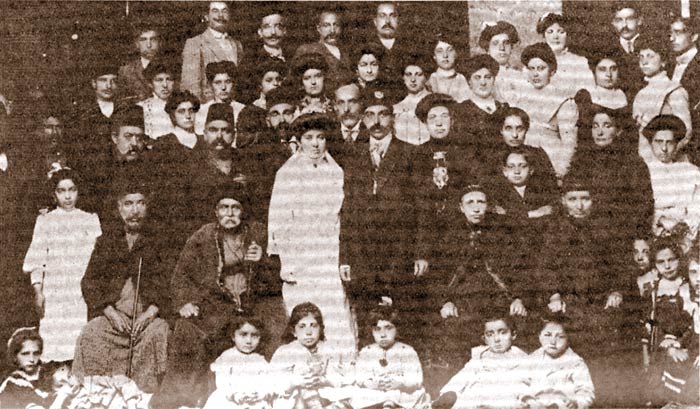
Armenian Wedding 1910
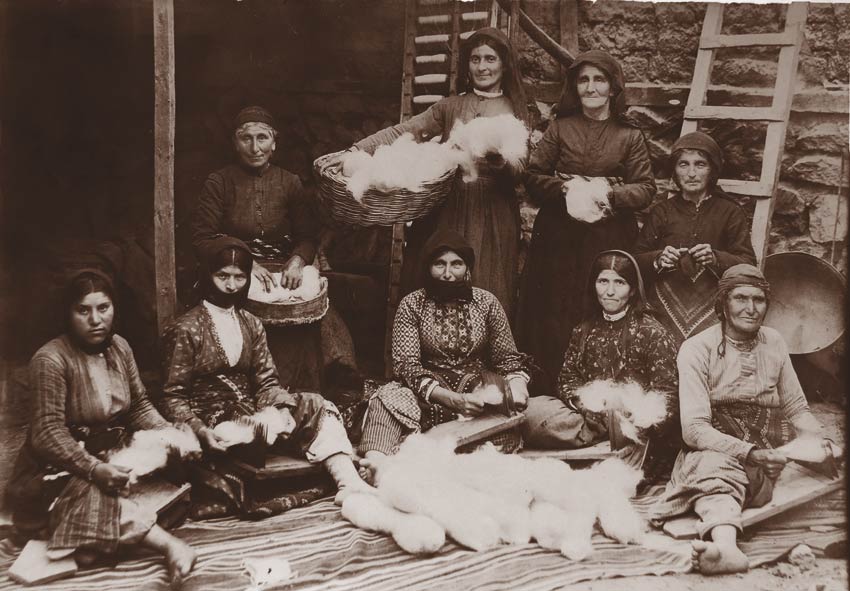
Women in Van carding wool
|
- Armenia - Country and History
|
Instruments:
|
|
|
- left: Norayr Kartashyan: zurna, pku (shawn), dhol
- Zurna (wind instrument)
Folk oboe of the Arab world, Turkey, southeast Europe and parts of Asia. It takes many forms but is most commonly a conical wooden tube with a double reed and usually a piroutte. It is also found as "zurna" in the Caucasus (Armenia, Daghestan, Azerbaijan and to a lesser extent in Georgia).
- Schawn - folk clarinet or hornpipe (wind-instrument)
It has a single reed which may be covered by a mouthpiece (or "wind-cap"). There is a wooden barrel with finger-holes and a flared bell. It can be made of various natural or man-made materials; cow horn bells are common, but all-wood. The instrument has a diatonic tuning which comes in various keys (G, A, F) and in soprano (i.e. "normal), alto, and even piccolo forms. They can be tuned by adjusting the reeds. The instrument is normally tuned in the key of G (you get all naturals, no accidentals), and you only get one octave's worth of notes. You can also get the final non-diminished 7th tone with alternate fingering.
|
|
|
|
|
 |
- Dhol (larger) - Davul (smaller) (percussion instrument)
Double-headed cylindrical drum. One membrane is thick and produces a deep sound, while the other one is thinner, generating a higher pitch. The membranes are made of sheepskin or goatskin, which are tensioned to each other by a variety of zigzag lacing around the cylinder. It is either played with two wooden sticks (one usually thicker than the other) on both membranes, or with the fingers and palms on one membrane. A variety of dances and songs are accompanied by the dhol. Many rhythmic patterns are used, giving the music an improvisatory character and its beat. In medieval times, the dhol was also known as the gos.
|
|
- more information about Traditional music and instruments of Armenia
|
